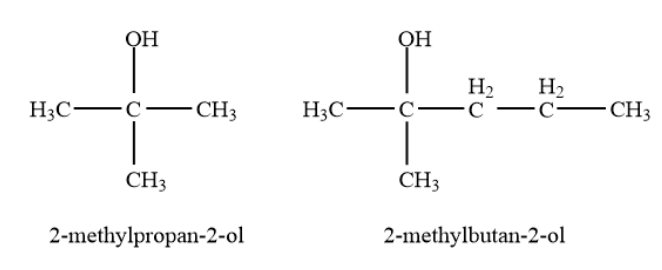
What are primary, secondary, and tertiary alcohols? Give one example of each.
Answer
417.6k+ views
1 likes
Hint: Alcohols have –OH group attached to the alkyl groups. The three types of alcohols, primary, secondary, and tertiary are determined by the position of the hydroxyl functional group attached to the alkyl group. Just write the definition of all the three types and give one example each.
Complete answer:
Alcohol is any class of organic compounds characterized by the presence of one or more hydroxyl (―OH) groups attached to a carbon atom of an alkyl group (hydrocarbon chain).
Based upon the presence of hydroxyl group attached to the alkyl group and the location of this hydroxyl group the alcohols are differentiated into primary, secondary, and tertiary.
Primary alcohols- In a primary

Secondary alcohols- In a secondary

Tertiary alcohols-In a tertiary

Note:
Alcohols can also have multiple hydroxyl groups instead of one. If an alcohol has two hydroxyl groups then it is called diols, if it has three hydroxyl groups then it is triols, and so on. Alcohols are an important class of compounds. Alcohols may be considered as organic derivatives of water
Complete answer:
Alcohol is any class of organic compounds characterized by the presence of one or more hydroxyl (―OH) groups attached to a carbon atom of an alkyl group (hydrocarbon chain).
Based upon the presence of hydroxyl group attached to the alkyl group and the location of this hydroxyl group the alcohols are differentiated into primary, secondary, and tertiary.
Primary alcohols- In a primary

Secondary alcohols- In a secondary

Tertiary alcohols-In a tertiary

Note:
Alcohols can also have multiple hydroxyl groups instead of one. If an alcohol has two hydroxyl groups then it is called diols, if it has three hydroxyl groups then it is triols, and so on. Alcohols are an important class of compounds. Alcohols may be considered as organic derivatives of water
Recently Updated Pages
Master Class 11 Business Studies: Engaging Questions & Answers for Success

Master Class 11 Accountancy: Engaging Questions & Answers for Success

Master Class 11 Computer Science: Engaging Questions & Answers for Success

Master Class 11 English: Engaging Questions & Answers for Success

Master Class 11 Social Science: Engaging Questions & Answers for Success

Master Class 11 Economics: Engaging Questions & Answers for Success

Trending doubts
Which one is a true fish A Jellyfish B Starfish C Dogfish class 11 biology CBSE

State and prove Bernoullis theorem class 11 physics CBSE

1 ton equals to A 100 kg B 1000 kg C 10 kg D 10000 class 11 physics CBSE

In which part of the body the blood is purified oxygenation class 11 biology CBSE

One Metric ton is equal to kg A 10000 B 1000 C 100 class 11 physics CBSE

Difference Between Prokaryotic Cells and Eukaryotic Cells




